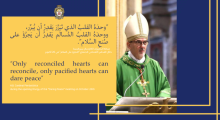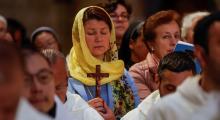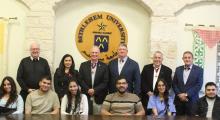Issued by the Catholic Center for Studies and Media - Jordan. Editor-in-chief Fr. Rif'at Bader - موقع أبونا abouna.org

During all the years he has worked as an assistant to the Franciscan Fathers at the Church of the Holy Sepulcher, Jeries Majlaton has never seen the streets of the Old City of Jerusalem so deserted.
He said there were always some tourists visiting the city or pilgrims coming to pray at the holy sites, providing a bit of income to local businesses.
But for the past seven months, since the outbreak of the COVID-19 pandemic, Majlaton has been walking along emptied and shuttered streets on his way to work, where he is now the only one of six assistants still helping the Franciscans prepare for their Masses, processions and maintaining the Franciscan Chapel of St. Mary Magdalene.
“There is sadness,” he said. “I have never seen the city like this. I come through the Christian Quarter, and I don’t see any of the shops open. I don’t see any of the shop owners. I know everybody and now I don’t see any of them.”
The Mount of Olives, with its numerous holy sites, including the Carmelite Church of the Pater Noster, where Jesus taught the Lord’s Prayer to His disciples, and the Franciscan Church of Gethsemane, where Jesus prayed during his agony, also is empty of pilgrims. The Church of the Pater Noster is closed, but the gates of the Gethsemane Garden and church doors are open if someone wants to come in briefly to pray. Only the guard sits in his office by the gate, and the Franciscans who generally greet visitors are inside their monastery.
For shopkeepers and business owners in the Old City of Jerusalem, the opening and closing has been of little relevance, because their main income base of tourists has not returned, and it is unclear how long it will be before the tourism sector is able to revive itself. Food stores and pharmacies are permitted to remain open, but with people able to move just over half a mile from their homes, customers are limited.
Outside the gates of the Old City, border police check for face masks and verify identity cards to make sure only people living within the half-mile limit come into the Old City.
Between the Fifth and Sixth stations on the Via Dolorosa, Husnei Kashur, 50, sits on a low stool in front of the open souvenir shop, where he has been working with his friend for the past six years. The threat of a $1,500 fine for having the store open does not faze him. His is the lone store open along the entire stretch and, except for a few locals walking to and from food stores. He is alone on the street.
“It is worse than staying at home, so I come here to breathe some air. The owner of that hummus restaurant just down there sold all his equipment and closed down his restaurant,” Kashur said, gesturing with his chin to a shuttered shop a few yards away. “He managed to pay rent for a few months, but then he closed it. He didn’t have any customers.”
Inside the silent Church of the Holy Sepulcher, Zarifis Zarifopulous, 53, sits atop some scaffolding, working on restoration of a 300-year-old Greek Orthodox icon of St. Gregory Palamas, bishop of his hometown of Thessaloniki, Greece. The saint preferred a monastic contemplative life of silence and prayer before he was called on to become bishop, explained Zarifopulous, so the artist said perhaps it is fitting to restore his icon in the quiet church.
“But I also love when there are people here. We also need to have people here, more pilgrims. It makes us more fresh, it brings soul-to-soul, person-to-person. It gives us a great personality to create,” said Zarifopulous, who began working on the icon at the beginning of the outbreak. “But iconography also needs these conditions, the quietness, the (calmness), especially for this art. I love all periods.”







